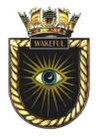HMS Wakeful (1943)
 HMS Wakeful underway on 28 February 1944
| |
| History | |
|---|---|
| Name | HMS Wakeful |
| Ordered | 3 December 1941 |
| Builder | Fairfield Shipbuilding and Engineering Company, Govan, Scotland |
| Laid down | 3 June 1942 |
| Launched | 30 June 1943 |
| Commissioned | 17 February 1944 |
| Identification |
|
| Motto |
|
| Fate | Sold for scrap on 10 June 1971 |
| Badge | |
| General characteristics as W class | |
| Class and type | W-class destroyer |
| Displacement | |
| Length | 362.75 ft (110.57 m) o/a |
| Beam | 35.75 ft (10.90 m) |
| Draught | 10 ft (3.0 m) |
| Propulsion |
|
| Speed | 36 knots (67 km/h; 41 mph) / 32 knots (59 km/h; 37 mph) full |
| Range | 4,675 nautical miles (8,658 km; 5,380 mi) at 20 knots (37 km/h; 23 mph) |
| Complement | 179 (225 as leader) |
| Sensors and processing systems |
|
| Armament |
|
| General characteristics Type 15 frigate | |
| Class and type | Type 15 frigate |
| Displacement | 2,300 tons (standard) |
| Length | 358 ft (109 m) o/a |
| Beam | 37.75 ft (11.51 m) |
| Draught | 14.5 ft (4.4 m) |
| Propulsion |
|
| Speed | 31 knots (57 km/h; 36 mph) (full load) |
| Complement | 174 |
| Sensors and processing systems | |
| Armament |
|
HMS Wakeful was a
. She was sold for scrap in 1971.Construction
HMS Wakeful was a W-class destroyer ordered from
Service history
Second World War
Wakeful joined the
Throughout June and July 1944 she was refitted for redeployment to the
In January 1945 she took part in
Post war
Between 1948 and 1950 her captain was Commander Royston Wright.
Wakeful was used as a Boys Training ship until she was converted to a
She was assigned the new pennant number F159 and served in the Mediterranean as a part of the 5th Frigate Squadron until 1957. During this time she took part in Operation Musketeer, the Anglo-French assault on Port Said to take control of the Suez Canal. In 1959 she recommissioned as leader of the Portsmouth Squadron, as a training tender to the Navigational Training School at HMS Dryad, and as trials ship to the Admiralty Surface Weapons Establishment (ASWE). On 25 February 1960 she was used for the burial at sea of Edwina Mountbatten, Countess Mountbatten of Burma off the coast of Portsmouth. On 25 August 1960, the destroyer Battleaxe was carrying out steam trials while moored alongside the minelayer Apollo at Portsmouth, when steam was let into the ship's turbines, driving the ship forward and breaking Apollo's mooring lines. Apollo then collided with Wakeful, which also broke free from her moorings and struck the caisson at the entrance to a dock. Apollo's stem was damaged, while Wakeful suffered buckled plates from the impact by Apollo and a badly damaged bow from the collision with the caisson.[3]
In April 1964 she was part of the
Between 1966 and 1967 she was fitted with experimental satellite communication equipment and stabilisers for trials. In 1968 she took part in 'Navy Days' at Portsmouth Dockyard and at this time was part of the 2nd Frigate Squadron.[1] On 31 October 1967 she escorted the RMS Queen Mary out of Southampton on her final voyage to Long Beach for retirement. In August 1968 she took part in the Western Fleet Review that sailed 50 ships in a review of the fleet carried out by the newly promoted Admiral of the Fleet Sir Varyl Begg on his retirement.
HMS Wakeful (Commanded by Lt.Cdr. David Whitehead) also went up the Ouistreham Canal for the 25th Anniversary of D Day in June 1969. Later that year she was replaced by Grenville.[5] and Lieutenant Commander David Whitehead was transferred to HMS Grenville as her new commanding officer at this time.
Decommissioning and disposal
In 1970 Wakeful was put on the Disposal List, and on 26 February left Portsmouth for de-equipping. She was sold to Thos. W. Ward for scrapping on 10 July 1971 and arrived in tow at Inverkeithing for demolition on 5 July that year.[6]
Affiliations
- Official affiliation
Notes
- ^ a b Programme, Navy Days at Portsmouth August 31st-September 2nd 1968, p. 15.
- ^ Souvenir Programme, Coronation Review of the Fleet, Spithead, 15th June 1953, HMSO, Gale and Polden.
- ^ "Apollo, Torn From Wall by Battleaxe, Rams Wakeful". Navy News. September 1960. p. 1. Retrieved 24 August 2018.
- ^ Programme, Navy Days Portsmouth, 1965. HMSO.
- ISBN 0-9506323-9-2.
- ^ Mason, Geoffrey B. (2001). Gordon Smith (ed.). "HMS Wakeful (ii) (R 59) – W-class Destroyer". Retrieved 1 May 2015.
References
- Barnett, Correlli (2000). Engage the enemy more closely : Royal Navy in the Second World War. London: Penguin Classic Military History. ISBN 0-14-139008-5.
- ISBN 978-1-86176-281-8.
- de S. Winser, John (1999). B.E.F. ships Before, at and After Dunkirk. World Ship Society. ISBN 0-905617-91-6.
- Raven, Alan; Roberts, John (1978). War Built Destroyers O to Z Classes. London: Bivouac Books. ISBN 0-85680-010-4.
- Whitley, M. J. (1988). Destroyers of World War 2. Annapolis, Maryland: Naval Institute Press. ISBN 0-87021-326-1.

